
SkyBOOKS Aviation Management Solutions

Paperwork, paperwork and more paperwork! Why is it we can work on a helicopter loaded with digital equipment, call for help on our digital cell phone, and buy what we need to support maintenance activities online with our digital computer, but we still have to record and track everything in an analog way? You got it — paperwork. Not anymore! SkyBOOKS provides a robust aircraft maintenance tracking solution for a single aircraft or an entire fleet. Due lists, discrepancy tracking and airworthiness directives are available anywhere, anytime, via secure Web access.
According to John Willis, Chief Operating Officer at SkyBOOKS, “SkyBOOKS is a Web-based integrated flight operations, maintenance management, inventory management, and electronic documentation tool allowing operators to maintain statutory, regulatory and safety compliance across all operational elements. SkyBOOKS is a Textron company, and was founded to efficiently improve aviation safety and regulatory compliance through the use of intuitive technology.”
He adds that predictive maintenance tracking allows SkyBOOKS to side step potential downtime. SkyBOOKS tracks hours, cycles and landings on all components and life-limited parts and checks maintenance status and MMEL status on any aircraft. The user can review airworthiness directives and service bulletin compliance, as well as access interactive due lists.
SkyBOOKS functions in four areas: flight operations, maintenance tracking, electronic document archiving and vault, and inventory and tool management. Since HeliMx is devoted to maintenance functions, we will not discuss the functional area dealing with flight operations.
Maintenance Tracking
Maintenance tracking is the heart of SkyBOOKS, and is created by extracting all requirements from the OEM manuals for life-limit, overhaul, inspection, lubrication sections or operator AAIP, plus any ICA, FAA AD, ASB or FAR requirements. Once a template is completed for all configurations, the actual aircraft data elements are populated to project future activity. When manual revisions or directives are issued, the system is updated and operators are notified of new actions to be addressed via intuitive icons and e-mail notification.
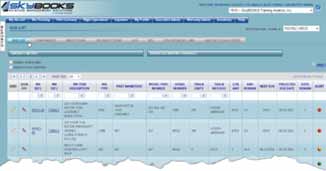
The aircraft due list orders each item by its next projected due date, including those that are hourly or cycle driven to ease the complexity of out of phase activities and reduce downtime. Every requirement can be searched by any criteria, and all items reference the requirement origin. Multiple user reports are available to allow operators to see upcoming activity, plan future parts demand, run predictive maintenance reports based on seasonal or changing flight utilization, or to select the best aircraft for specific missions. SkyBOOKS functionality allows individuals to change flight utilization factors at will and see the immediate impact.
Component Management
Component nomenclature, serial numbers, life limits, meter status, historical record cards, FAA forms, engineering reports or even video files can be attached directly to components. The data will follow the components even when transferred between aircraft, returned to inventory or sent to a repair/overhaul facility. Component validation and conformity is simplified significantly. Component warranty expiration is also tracked using the color-coded alert system and confirmed by the original purchase documentation, regardless of aircraft movements.
Electronic Document - Archiving and Vault
The document vault is a structured electronic file system that organizes all records. Each aircraft has organized file folders containing original signature documents to include aircraft log books, engine log books, HSR cards, FAA Forms, STCs, wiring diagrams, flight logs, etc. Vault documents, unlike the documents attached to components, remain in the aircraft folders as a historical record for the life of the aircraft. All documents may be accessed in read-only form by approved crew members or maintainers worldwide to aid in troubleshooting or system repair. The file convention allows for all documents or video file formats. Information may be uploaded directly from the operator’s personal computer or forwarded to an analyst for loading. The aircraft residual value is significantly enhanced as a result.
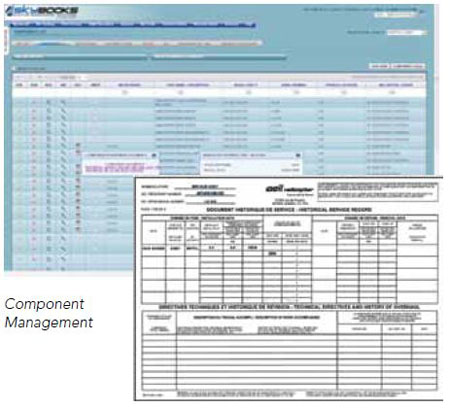
Inventory and Tool Management
The parts inventory module tracks components, consumables, shelf-life expiration and tool calibration, and supports an infinite number of custom locations. Inventory can even be managed in operator customizable categories like airframe, avionics, engine, hydraulic, or components, consumable, tools and cores. The module maintains approved supplier information, a parts transaction register, alternative and superseded parts numbers, AD/mod status of components and alerts for min/MAX quantities, shelf-life expiration and approaching tool calibration. Many OEM parts masters are preloaded with alternative and superseded parts numbers, eliminating the need for new parts creation.
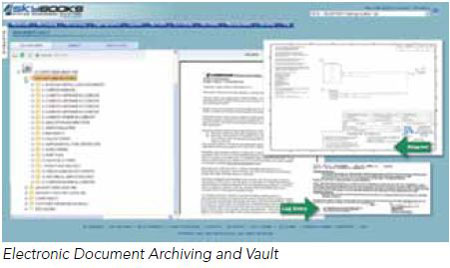
The following is from a conversation between HeliMx and Willis.
HeliMx – Which helicopters can currently use the system?
Willis – The SkyBOOKS methodology and architecture allows it to support virtually any platform. Today, the customer base ranges from Robinson R22 trainers to Tri-Motor transcontinental business jets. SkyBOOKS currently support 20 OEM product lines and this year will approach 100 unique aircraft models. Some of the major helicopter OEMs supported include AgustaWestland, Bell Helicopter, Enstrom, Eurocopter, Kawasaki, MD Helicopters, Robinson, Sikorsky and Russian Helicopters.
SkyBOOKS is currently being utilized by general aviation operators worldwide. We have users in North, South and Central America, the Caribbean, Europe, Africa, the Middle East, India, Asia, Indonesia, New Guinea and Australia, to name a few. U.S. service also extends to Hawaii.
HeliMx – Is the system software- or hardware-based, or both?
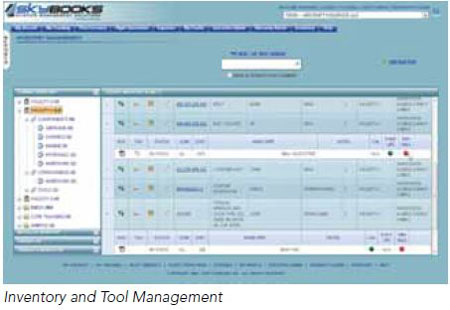
Willis – SkyBOOKS is an SAAS (Software as a Service)-based entity maintained in a Tier 4 data center in Jacksonville, Fla., and has a second hot roll over data storage facility in Nashville, Tenn. Each night all customer data files are downloaded to a tape drive and stored in a bank vault. The operator only needs a PC computer, tablet, EFB or iPad and an internet portal to access the system. All IT security, back up, hardware, configuration, updates and upgrades are handled seamlessly by our IT department.
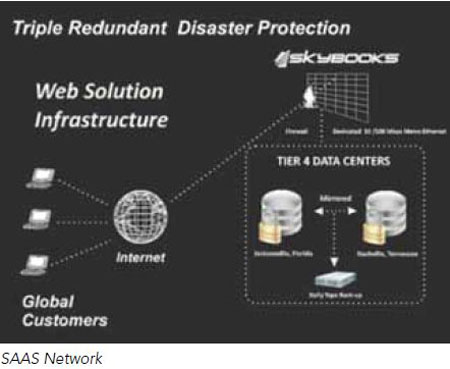
HeliMx – How much work is required by the operator to input the starting data into the system?
Willis – None. All initial aircraft loading is accomplished by our analysts. Quality assurance ensures the aircraft template is current to the latest maintenance manual revision and all ADs are listed. Then, our analysts populate data from the customer-supplied information. The customer may have us load information from their current spreadsheet or have complete document verification from actual log book entry review, either of which will generate a deviation report of undocumented action items. At that point, our account representatives will work with the operator to reconcile any initial deviations.
HeliMx – What are the benefits of the system for the maintenance professional?
Willis – Maintenance personnel are able to focus more on actual repairs and planning as a result of their SkyBOOKS relationship. Many consider SkyBOOKS as their outsourced quality and administrative department. The quality assurance team and account representatives are always available to help answer technical or system questions. Customers report that internal and external audits become much easier when all documents and records are well organized and at their fingertips.
HeliMx – How does the system improve aircraft readiness tracking and availability?
Willis – Work task cards are available for single or collective tasks, which can be assigned to individuals or MROs for corrective action. Task cards are extracted from the due list so they conveniently group all tasks together, whether calendar or cycle driven, eliminating the risk of out of phase activity and downtime. Tasks are individually reviewed and selected and can be printed in individual or group cards for execution.
Task cards are populated with the aircraft current meter values, task nomenclature, manual references, PN/SN of installed components and even a man-hour standard and parts cost if desired. Work expectations are clearly defined and controlled via system generated instructions. All task cards have the return to service and signature information to serve as the actual log book entry.
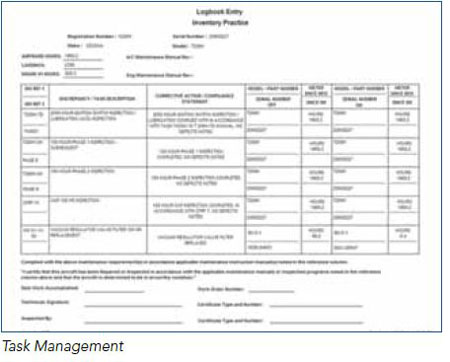
HeliMx – How does the system help the operator manage working on discrepancies?
Willis – Scheduled and unscheduled maintenance, including MMEL items, are all tracked within the system which can also generate work task cards for corrective actions. The open discrepancies are tracked in a current discrepancy section that identifies the issue, depicts the current status, who reported the issue, the technician involved, the airworthiness status, tracks the aging process and reports the suspense data via a colored icon alert. When the discrepancy or MMEL item has been closed, it transfers to the closed section and becomes part of the aircraft permanent maintenance record. Repetitive issues or prior system-related discrepancies become rapidly apparent, eliminating redundant or nonproductive effort.
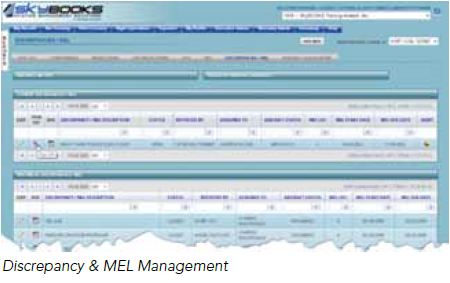
HeliMx – How does the system help the operator in tracking maintenance tasks?
Willis – SkyBOOKS provide operators several tools and ways to look at approaching maintenance. Traditional reports are available for operators to see what is due in the next user-defined number of days, hours, cycles, RIN or by any associated meter. The most intuitive method is our due list page, which takes projected monthly average consumption of all meters and projects a calendar date when items will come due. The system then sequentially lists all items based upon due date for maintenance planning and efficiency. This approach eliminates grounding aircraft for out-of-phase calendar or cycle surprises. The intuitive approach allows operators and maintainers to change operating utilizations on the fly and rapidly see the impact on the maintenance schedule, or to select the correct aircraft for specific missions. Remote flight operations are greatly simplified by selecting the best aircraft for the extended mission.
HeliMx – Does the system help the operator keep up with maintenance compliance?
Willis – System design provides operators intuitive alerts and metrics to visually know when requirements are approaching, not just overdue. Utilizing a three-color metric system, we are able to provide variable alerts for planning any maintenance event or provide crew members reminders for physicals, check rides, and flight or simulator checks. AD/ASB information has highly visible indicators delivered and replicated in the dispatch, AD and maintenance due areas in addition to the e-mail launch to ensure crew members, dispatchers and maintainers are all aware of pending requirements.
HeliMx – Does the system keep track and inform the maintenance professional of required upcoming maintenance tasks?
Willis – The aircraft fleet view, aircraft status page and aircraft due list illustrate green, yellow and red operating conditions as maintenance requirements approach. The operator can select the number of yellow alert days before an item turns red.
HeliMx – Does the system provide output for maintenance history on the aircraft it is tracking?
Willis – The system provides visibility (who, when, what) related to changes on all transactions. Multiple reports are available that track parts number quantities and frequency of installed components. When discrepancies are moved to the closed discrepancy, list they reflect data (who, when, what) outlining how the items were closed. The closed item remains on the list and makes it easy to see recurring or related issues in a single location.
HeliMx – Is the system integrated with inspection authorization compliance, the aircraft maintenance manual or other documentation?
Willis – Yes. Master templates are maintained so when engine, airframe or APU manual revisions are issued, an alert is sent and the intervals are updated to latest requirements. If an operator decision is required on the implementation timeline, the account representative works the compliance impact individually with the operator.
HeliMx – Is the system linked to any outside data sources?
Willis – The system is designed using .NET Architecture and has application interface (API) capability for third-party platforms. Currently, we have several in use for specific customer needs.
HeliMx – Can the system generate reports, and in what form?
Willis – SkyBOOKS provides many standard repetitive individual aircraft and fleet reports which operators can execute locally. We have also developed custom reports for individual users to extract specific information they require. Unique reports are requested through our account representatives and, if recurring, pushed to the individual account unless deemed beneficial to all users. SkyBOOKS utilizes Microsoft Office standard tool set, so all report data can be exported into Excel, Word or PDF for e-mail, data charting or additional management.
HeliMx – Does the system integrate with any other systems, like HUMS?
Willis – The system has an internal API and may interface with any data exchange system. It is solely a matter of mapping input/output data elements.
HeliMx – Is there a minimum number of aircraft required to make the system cost effective?
Willis – No, SkyBOOKS is individually unit priced. SkyBOOKS for less complex aircraft with fewer tracking item requirements are priced lower than larger more complex machines. Since no special hardware or tools are required, the entry level threshold is nonexistent.
HeliMx – Is the system scalable for different size fleets?
Willis – Yes, SkyBOOKS is completely scalable and managed on our side. We have some single ship operators and several fleet operators. One 28-ship operator (in the past 12 months) generated:
Aircraft units 28
Number of users 225
Fleet Total Flight Hours 32,948
Posted Flight Logs 14,873
Pilot currency tracking items 1,115
Total Passengers Flown 942,814
Fuel Consumption, Liters 9,196,851
Component Transfers between A/C 6,958
SkyBOOKS Component R&Rs 10,561
Current inventory Line items 3,963
Newly Installed Components 7,769
Maintenance Requirements Managed 7,202
HeliMx – Are there system options?
Willis – Yes. SkyBOOKS is offered in three forms, and the customer may select either user- or analyst-managed service levels.
1. Full service: flight operations, maintenance tracking, document vault and inventory
2. Lite plus: maintenance tracking, document vault, and optional inventory
3. Document vault only
HeliMx – How is system training provided?
Willis – SkyBOOKS account representatives provide online Web user training during the initialization process. Additionally, there are system-embedded video tutorials in English and Spanish for each functional activity. Our users find them to be very helpful in refreshing skills and learning best practices. On-site training options are offered in Jacksonville, Fla., and Fort Worth, Texas, or at the customer’s facility on an additional cost basis.
At last, a digital solution to paperwork! SkyBOOKS Web-based software tool is the right stuff at the right time. It’s computer driven and accessible from just about anywhere. It’s an interactive maintenance management tool that records, manages and reports essential aircraft compliance information. If you’re looking for a tool that reduces your maintenance department’s management labor hours by providing a faster, easier way to access up-to-the-minute airworthiness information on your aircraft, maybe SkyBOOKS is worth a look.
John Willis is a senior marketing and operations executive specializing in the aircraft sales and maintenance services segment of the general aviation industry. He is experienced in aligning complex automated business processes with enterprise resource technologies utilized by flight department operators and FAR Part 145 repair station networks.
During a 29 year career at Raytheon/Beech Aircraft, he served 10 years as RAS President and 19 years as VP of Aircraft Sales and VP of Operations over a global 32 location network.
 John is certified as an Airline Transport Pilot in both fixed and rotary wing aircraft and is type rated in numerous aircraft. John is a dual rated U.S. Army aviator and Vietnam helicopter veteran. He is a past officer/board member of both the National Air Transportation Association, and the Professional Aviation Maintenance Association.
John is certified as an Airline Transport Pilot in both fixed and rotary wing aircraft and is type rated in numerous aircraft. John is a dual rated U.S. Army aviator and Vietnam helicopter veteran. He is a past officer/board member of both the National Air Transportation Association, and the Professional Aviation Maintenance Association.
